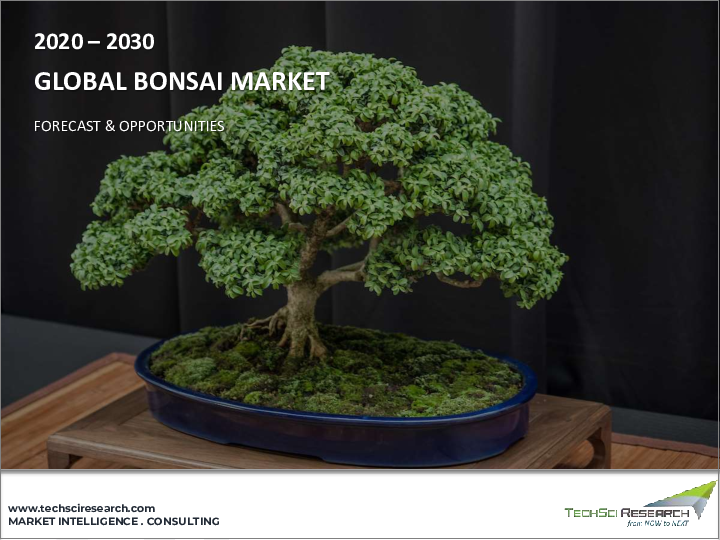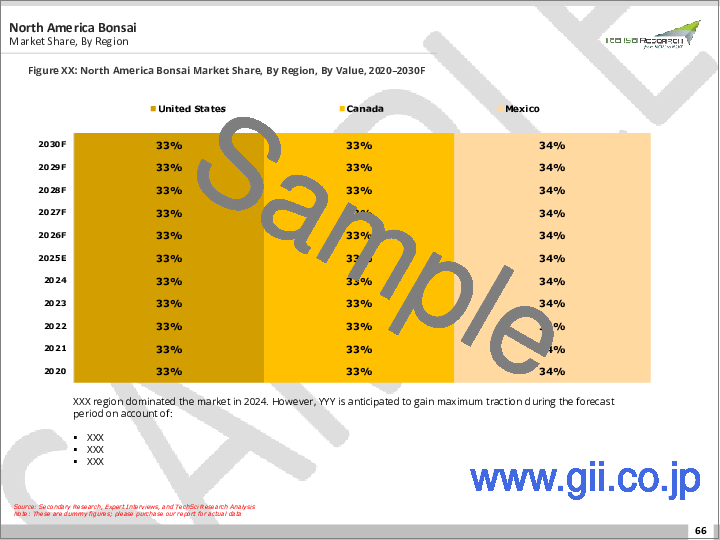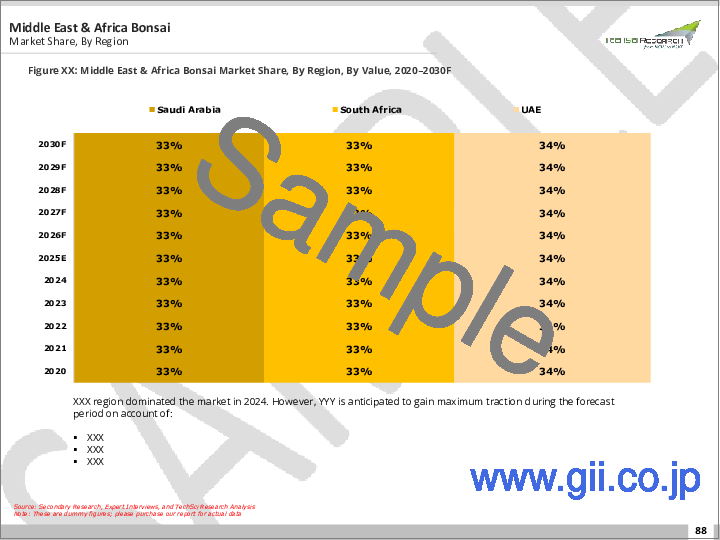|
|
市場調査レポート
商品コード
1668190
盆栽市場- 世界の産業規模、シェア、動向、機会、予測、タイプ別、スタイル別、流通チャネル別、地域別、競合別、2020~2030年Bonsai Market - Global Industry Size, Share, Trends, Opportunity, and Forecast, Segmented By Type, By Style, By Distribution Channel, By Region and Competition, 2020-2030F |
||||||
カスタマイズ可能
|
|||||||
| 盆栽市場- 世界の産業規模、シェア、動向、機会、予測、タイプ別、スタイル別、流通チャネル別、地域別、競合別、2020~2030年 |
|
出版日: 2025年02月28日
発行: TechSci Research
ページ情報: 英文 175 Pages
納期: 2~3営業日
|
全表示
- 概要
- 目次
盆栽の世界市場規模は2024年に21億1,000万米ドル、2030年には34億4,000万米ドルに達し、予測期間中のCAGRは8.49%で成長すると予測されています。
日本の伝統芸術である盆栽は、コンテナで小さな樹木を栽培し、小型化しながらもリアルな自然を表現することを目的としています。これらの樹木は遺伝的に矮小化されているわけではなく、枝や根を丹念に剪定することで小さなサイズを維持し、美的バランスを確保しています。盆栽市場は、盆栽樹木の栽培、流通、販売に関する商業活動を包含しており、趣味家やプロのコレクターの両方に対応しています。この市場では、初心者向けの樹木から複雑な彫刻が施された標本まで、さまざまな製品を提供しており、鉢、混合用土、道具、教材などの付属品も含まれます。
| 市場概要 | |
|---|---|
| 予測期間 | 2026-2030 |
| 市場規模:2024年 | 21億1,000万米ドル |
| 市場規模:2030年 | 34億4,000万米ドル |
| CAGR:2025年~2030年 | 8.49% |
| 急成長セグメント | 屋内盆栽樹木 |
| 最大市場 | アジア太平洋 |
盆栽に対する世界の関心の高まりと、日本におけるその深い文化的意義が相まって、国際的な需要が増加し、盆栽は園芸業界の重要なセグメントとして確立されました。さらに、メンタルヘルスとウェルネスへの注目が高まっていることも、盆栽の木の人気上昇に寄与しています。調査によると、ガーデニング、特に盆栽の栽培は治療効果があり、マインドフルネスを促進し、ストレスを軽減し、感情的な幸福感を高めるといいます。この動向は、特に北米や欧州のような先進地域における、ホリスティックな生活を目指す幅広い動きと一致しています。例えば、米国では2024年に2万4,642を超えるナーサリー&ガーデン事業者が誕生したが、これは植物栽培への関心の高まりを反映しています。持続可能な生活に対する欧州のコミットメントも、盆栽農業の増加につながっており、市場拡大をさらに促進しています。
目次
第1章 概要
第2章 調査手法
第3章 エグゼクティブサマリー
第4章 世界の盆栽市場展望
- 市場規模・予測
- 金額別
- 市場シェア・予測
- タイプ別(屋内盆栽樹木、屋外盆栽樹木)
- スタイル別(正立盆栽、ほうき盆栽、斜盆栽、その他)
- 流通チャネル別(店舗型と非店舗型)
- 地域別
- 企業別(2024)
- 市場マップ
第5章 北米の盆栽市場展望
- 市場規模・予測
- 金額別
- 市場シェア・予測
- タイプ別
- スタイル別
- 流通チャネル別
- 国別
- 北米:国別分析
- 米国
- カナダ
- メキシコ
第6章 欧州の盆栽市場展望
- 市場規模・予測
- 市場シェア・予測
- 欧州:国別分析
- ドイツ
- 英国
- イタリア
- フランス
- スペイン
第7章 アジア太平洋地域の盆栽市場展望
- 市場規模・予測
- 市場シェア・予測
- アジア太平洋地域:国別分析
- 中国
- インド
- 日本
- 韓国
- オーストラリア
第8章 南米の盆栽市場展望
- 市場規模・予測
- 市場シェア・予測
- 南米:国別分析
- ブラジル
- アルゼンチン
- コロンビア
第9章 中東・アフリカの盆栽市場展望
- 市場規模・予測
- 市場シェア・予測
- 中東・アフリカ:国別分析
- 南アフリカ
- サウジアラビア
- アラブ首長国連邦
第10章 市場力学
- 促進要因
- 課題
第11章 市場動向と発展
- 最近の動向
- 合併と買収
- 製品上市
第12章 世界の盆栽市場:SWOT分析
第13章 ポーターのファイブフォース分析
- 業界内の競合
- 新規参入の可能性
- サプライヤーの力
- 顧客の力
- 代替品の脅威
第14章 競合情勢
- MiniGardens Bonsai NZ Ltd.
- Circle City Bonsai
- Lodder Bonsai BV
- Dongyi Artificial Plants Co. Limited
- RUSSEL'S BONSAI
- Bonsai Direct
- Kaizen Bonsai Ltd.
- Bonsai Sensation Nursery
- California Bonsai Studio
- Ganga Nursery
第15章 戦略的提言
第16章 調査会社について・免責事項
The global Bonsai market was valued at USD 2.11 billion in 2024 and is projected to reach USD 3.44 billion by 2030, growing at a CAGR of 8.49% during the forecast period. Bonsai, a traditional Japanese art form, involves cultivating small trees in containers, aiming to create a miniaturized but realistic representation of nature. These trees are not genetically dwarfed but are maintained at a smaller size through meticulous pruning of branches and roots, ensuring an aesthetic balance. The Bonsai market encompasses the commercial activities surrounding the cultivation, distribution, and sale of bonsai trees, catering to both hobbyists and professional collectors. This market offers a range of products, from beginner-friendly trees to intricately sculpted specimens, and includes accessories such as pots, soil mixtures, tools, and instructional materials.
| Market Overview | |
|---|---|
| Forecast Period | 2026-2030 |
| Market Size 2024 | USD 2.11 Billion |
| Market Size 2030 | USD 3.44 Billion |
| CAGR 2025-2030 | 8.49% |
| Fastest Growing Segment | Indoor Bonsai Trees |
| Largest Market | Asia Pacific |
The growing global interest in bonsai, coupled with its deep cultural significance in Japan, has led to increased international demand, establishing bonsai as a significant segment within the horticulture industry. Additionally, the rising focus on mental health and wellness has contributed to the increased popularity of bonsai trees. Research suggests that gardening, particularly bonsai cultivation, offers therapeutic benefits, promoting mindfulness, reducing stress, and enhancing emotional well-being. This trend aligns with the broader movement toward holistic living, particularly in developed regions like North America and Europe. For instance, the United States had over 24,642 nursery and garden businesses in 2024, reflecting the growing interest in plant cultivation. Europe's commitment to sustainable living has also led to a rise in bonsai farming, further driving market expansion.
Key Market Drivers:
Rising Interest in Household Plants and Miniaturization Trends:
The growing interest in indoor plants and miniaturized nature forms is driving the global demand for bonsai trees. These miniature trees, cultivated in pots, are integral to Japanese culture and offer an ideal solution for creating serene, green environments within confined urban living spaces. Their compact size and elegant aesthetics align with modern trends favoring miniaturization, making them not only decorative household items but also valuable collectibles. Additionally, bonsai cultivation involves careful attention and patience, catering to the increasing demand for mindful, therapeutic activities. The rise of e-commerce platforms has made a wider variety of bonsai trees more accessible, further enhancing global demand.
Key Market Challenges:
High Maintenance Costs:
High maintenance costs associated with bonsai cultivation pose a significant challenge to global demand. Bonsai trees, though admired for their aesthetic appeal, require substantial time and resource investment for upkeep. This includes regular pruning, watering, repotting, and protection against diseases and pests, as well as the use of specific soil types and fertilizers. The need for skilled care also increases overall expenses, making these ornamental plants less affordable and accessible to average consumers. As a result, budget-conscious consumers may opt for lower-maintenance, more affordable alternatives, which could slow market growth. To mitigate this challenge, the bonsai industry may need to introduce low-maintenance varieties or more affordable care services to sustain global interest.
Key Market Trends:
Advances in Bonsai Cultivation Techniques:
Technological advancements in bonsai cultivation, including precision irrigation and smart sensors for controlling light and temperature, are expected to drive a surge in demand. These innovations have made growing bonsai more efficient and less time-consuming. Furthermore, they have enabled hobbyists and gardeners to cultivate a broader range of species, expanding the market. Modern techniques also contribute to healthier, more visually appealing trees, which attract interior designers, landscapers, and homeowners looking for unique decorative pieces. The availability of online tutorials and virtual bonsai classes has democratized expert cultivation advice, encouraging more people worldwide to explore this ancient art form. As interest in minimalist and nature-inspired decor continues to grow, the global demand for bonsai trees is expected to rise significantly.
Key Market Players:
- MiniGardens Bonsai NZ Ltd.
- Circle City Bonsai
- Lodder Bonsai BV
- Dongyi Artificial Plants Co. Limited
- RUSSEL'S BONSAI
- Bonsai Direct
- Kaizen Bonsai Ltd.
- Bonsai Sensation Nursery
- California Bonsai Studio
- Ganga Nursery
Report Scope: This report segments the global bonsai market into various categories, analyzing industry trends in detail. The market is categorized by type, style, distribution channel, and region:
By Type:
- Indoor Bonsai Trees
- Outdoor Bonsai Trees
By Style:
- Formal Upright
- Broom
- Slanted Bonsai
- Others
By Distribution Channel:
- Store-based
- Non-store-based
By Region:
- North America: United States, Canada, Mexico
- Europe: France, United Kingdom, Italy, Germany, Spain
- Asia-Pacific: China, India, Japan, Australia, South Korea
- South America: Brazil, Argentina, Colombia
- Middle East & Africa: South Africa, Saudi Arabia, UAE, Kuwait, Turkey, Egypt
Competitive Landscape: This section offers a detailed analysis of key companies operating in the global bonsai market.
Available Customizations: TechSci Research provides customizable options for the global bonsai market report to cater to specific company needs, including detailed analysis and profiling of additional market players (up to five).
Table of Contents
1. Product Overview
- 1.1. Market Definition
- 1.2. Scope of the Market
- 1.2.1. Markets Covered
- 1.2.2. Years Considered for Study
- 1.2.3. Key Market Segmentations
2. Research Methodology
- 2.1. Objective of the Study
- 2.2. Baseline Methodology
- 2.3. Key Industry Partners
- 2.4. Major Association and Secondary Sources
- 2.5. Forecasting Methodology
- 2.6. Data Triangulation & Validations
- 2.7. Assumptions and Limitations
3. Executive Summary
- 3.1. Overview of the Market
- 3.2. Overview of Key Market Segmentations
- 3.3. Overview of Key Market Players
- 3.4. Overview of Key Regions/Countries
- 3.5. Overview of Market Drivers, Challenges, Trends
- 3.6. Voice of Customer
4. Global Bonsai Market Outlook
- 4.1. Market Size & Forecast
- 4.1.1. By Value
- 4.2. Market Share & Forecast
- 4.2.1. By Type (Indoor Bonsai Trees, Outdoor Bonsai Trees)
- 4.2.2. By Style (Formal Upright, Broom, Slanted Bonsai, Others)
- 4.2.3. By Distribution Channel (Store-based and Non-store-based)
- 4.2.4. By Region
- 4.2.5. By Company (2024)
- 4.3. Market Map
5. North America Bonsai Market Outlook
- 5.1. Market Size & Forecast
- 5.1.1. By Value
- 5.2. Market Share & Forecast
- 5.2.1. By Type
- 5.2.2. By Style
- 5.2.3. By Distribution Channel
- 5.2.4. By Country
- 5.3. North America: Country Analysis
- 5.3.1. United States Bonsai Market Outlook
- 5.3.1.1. Market Size & Forecast
- 5.3.1.1.1. By Value
- 5.3.1.2. Market Share & Forecast
- 5.3.1.2.1. By Type
- 5.3.1.2.2. By Style
- 5.3.1.2.3. By Distribution Channel
- 5.3.1.1. Market Size & Forecast
- 5.3.2. Canada Bonsai Market Outlook
- 5.3.2.1. Market Size & Forecast
- 5.3.2.1.1. By Value
- 5.3.2.2. Market Share & Forecast
- 5.3.2.2.1. By Type
- 5.3.2.2.2. By Style
- 5.3.2.2.3. By Distribution Channel
- 5.3.2.1. Market Size & Forecast
- 5.3.3. Mexico Bonsai Market Outlook
- 5.3.3.1. Market Size & Forecast
- 5.3.3.1.1. By Value
- 5.3.3.2. Market Share & Forecast
- 5.3.3.2.1. By Type
- 5.3.3.2.2. By Style
- 5.3.3.2.3. By Distribution Channel
- 5.3.3.1. Market Size & Forecast
- 5.3.1. United States Bonsai Market Outlook
6. Europe Bonsai Market Outlook
- 6.1. Market Size & Forecast
- 6.1.1. By Value
- 6.2. Market Share & Forecast
- 6.2.1. By Type
- 6.2.2. By Style
- 6.2.3. By Distribution Channel
- 6.2.4. By Country
- 6.3. Europe: Country Analysis
- 6.3.1. Germany Bonsai Market Outlook
- 6.3.1.1. Market Size & Forecast
- 6.3.1.1.1. By Value
- 6.3.1.2. Market Share & Forecast
- 6.3.1.2.1. By Type
- 6.3.1.2.2. By Style
- 6.3.1.2.3. By Distribution Channel
- 6.3.1.1. Market Size & Forecast
- 6.3.2. United Kingdom Bonsai Market Outlook
- 6.3.2.1. Market Size & Forecast
- 6.3.2.1.1. By Value
- 6.3.2.2. Market Share & Forecast
- 6.3.2.2.1. By Type
- 6.3.2.2.2. By Style
- 6.3.2.2.3. By Distribution Channel
- 6.3.2.1. Market Size & Forecast
- 6.3.3. Italy Bonsai Market Outlook
- 6.3.3.1. Market Size & Forecast
- 6.3.3.1.1. By Value
- 6.3.3.2. Market Share & Forecast
- 6.3.3.2.1. By Type
- 6.3.3.2.2. By Style
- 6.3.3.2.3. By Distribution Channel
- 6.3.3.1. Market Size & Forecast
- 6.3.4. France Bonsai Market Outlook
- 6.3.4.1. Market Size & Forecast
- 6.3.4.1.1. By Value
- 6.3.4.2. Market Share & Forecast
- 6.3.4.2.1. By Type
- 6.3.4.2.2. By Style
- 6.3.4.2.3. By Distribution Channel
- 6.3.4.1. Market Size & Forecast
- 6.3.5. Spain Bonsai Market Outlook
- 6.3.5.1. Market Size & Forecast
- 6.3.5.1.1. By Value
- 6.3.5.2. Market Share & Forecast
- 6.3.5.2.1. By Type
- 6.3.5.2.2. By Style
- 6.3.5.2.3. By Distribution Channel
- 6.3.5.1. Market Size & Forecast
- 6.3.1. Germany Bonsai Market Outlook
7. Asia-Pacific Bonsai Market Outlook
- 7.1. Market Size & Forecast
- 7.1.1. By Value
- 7.2. Market Share & Forecast
- 7.2.1. By Type
- 7.2.2. By Style
- 7.2.3. By Distribution Channel
- 7.2.4. By Country
- 7.3. Asia-Pacific: Country Analysis
- 7.3.1. China Bonsai Market Outlook
- 7.3.1.1. Market Size & Forecast
- 7.3.1.1.1. By Value
- 7.3.1.2. Market Share & Forecast
- 7.3.1.2.1. By Type
- 7.3.1.2.2. By Style
- 7.3.1.2.3. By Distribution Channel
- 7.3.1.1. Market Size & Forecast
- 7.3.2. India Bonsai Market Outlook
- 7.3.2.1. Market Size & Forecast
- 7.3.2.1.1. By Value
- 7.3.2.2. Market Share & Forecast
- 7.3.2.2.1. By Type
- 7.3.2.2.2. By Style
- 7.3.2.2.3. By Distribution Channel
- 7.3.2.1. Market Size & Forecast
- 7.3.3. Japan Bonsai Market Outlook
- 7.3.3.1. Market Size & Forecast
- 7.3.3.1.1. By Value
- 7.3.3.2. Market Share & Forecast
- 7.3.3.2.1. By Type
- 7.3.3.2.2. By Style
- 7.3.3.2.3. By Distribution Channel
- 7.3.3.1. Market Size & Forecast
- 7.3.4. South Korea Bonsai Market Outlook
- 7.3.4.1. Market Size & Forecast
- 7.3.4.1.1. By Value
- 7.3.4.2. Market Share & Forecast
- 7.3.4.2.1. By Type
- 7.3.4.2.2. By Style
- 7.3.4.2.3. By Distribution Channel
- 7.3.4.1. Market Size & Forecast
- 7.3.5. Australia Bonsai Market Outlook
- 7.3.5.1. Market Size & Forecast
- 7.3.5.1.1. By Value
- 7.3.5.2. Market Share & Forecast
- 7.3.5.2.1. By Type
- 7.3.5.2.2. By Style
- 7.3.5.2.3. By Distribution Channel
- 7.3.5.1. Market Size & Forecast
- 7.3.1. China Bonsai Market Outlook
8. South America Bonsai Market Outlook
- 8.1. Market Size & Forecast
- 8.1.1. By Value
- 8.2. Market Share & Forecast
- 8.2.1. By Type
- 8.2.2. By Style
- 8.2.3. By Distribution Channel
- 8.2.4. By Country
- 8.3. South America: Country Analysis
- 8.3.1. Brazil Bonsai Market Outlook
- 8.3.1.1. Market Size & Forecast
- 8.3.1.1.1. By Value
- 8.3.1.2. Market Share & Forecast
- 8.3.1.2.1. By Type
- 8.3.1.2.2. By Style
- 8.3.1.2.3. By Distribution Channel
- 8.3.1.1. Market Size & Forecast
- 8.3.2. Argentina Bonsai Market Outlook
- 8.3.2.1. Market Size & Forecast
- 8.3.2.1.1. By Value
- 8.3.2.2. Market Share & Forecast
- 8.3.2.2.1. By Type
- 8.3.2.2.2. By Style
- 8.3.2.2.3. By Distribution Channel
- 8.3.2.1. Market Size & Forecast
- 8.3.3. Colombia Bonsai Market Outlook
- 8.3.3.1. Market Size & Forecast
- 8.3.3.1.1. By Value
- 8.3.3.2. Market Share & Forecast
- 8.3.3.2.1. By Type
- 8.3.3.2.2. By Style
- 8.3.3.2.3. By Distribution Channel
- 8.3.3.1. Market Size & Forecast
- 8.3.1. Brazil Bonsai Market Outlook
9. Middle East and Africa Bonsai Market Outlook
- 9.1. Market Size & Forecast
- 9.1.1. By Value
- 9.2. Market Share & Forecast
- 9.2.1. By Type
- 9.2.2. By Style
- 9.2.3. By Distribution Channel
- 9.2.4. By Country
- 9.3. MEA: Country Analysis
- 9.3.1. South Africa Bonsai Market Outlook
- 9.3.1.1. Market Size & Forecast
- 9.3.1.1.1. By Value
- 9.3.1.2. Market Share & Forecast
- 9.3.1.2.1. By Type
- 9.3.1.2.2. By Style
- 9.3.1.2.3. By Distribution Channel
- 9.3.1.1. Market Size & Forecast
- 9.3.2. Saudi Arabia Bonsai Market Outlook
- 9.3.2.1. Market Size & Forecast
- 9.3.2.1.1. By Value
- 9.3.2.2. Market Share & Forecast
- 9.3.2.2.1. By Type
- 9.3.2.2.2. By Style
- 9.3.2.2.3. By Distribution Channel
- 9.3.2.1. Market Size & Forecast
- 9.3.3. UAE Bonsai Market Outlook
- 9.3.3.1. Market Size & Forecast
- 9.3.3.1.1. By Value
- 9.3.3.2. Market Share & Forecast
- 9.3.3.2.1. By Type
- 9.3.3.2.2. By Style
- 9.3.3.2.3. By Distribution Channel
- 9.3.3.1. Market Size & Forecast
- 9.3.1. South Africa Bonsai Market Outlook
10. Market Dynamics
- 10.1. Drivers
- 10.2. Challenges
11. Market Trends & Developments
- 11.1. Recent Development
- 11.2. Mergers & Acquisitions
- 11.3. Product Launches
12. Global Bonsai Market: SWOT Analysis
13. Porter's Five Forces Analysis
- 13.1. Competition in the Industry
- 13.2. Potential of New Entrants
- 13.3. Power of Suppliers
- 13.4. Power of Customers
- 13.5. Threat of Substitute Products
14. Competitive Landscape
- 14.1. MiniGardens Bonsai NZ Ltd.
- 14.1.1. Business Overview
- 14.1.2. Company Snapshot
- 14.1.3. Products & Services
- 14.1.4. Financials (As Reported)
- 14.1.5. Recent Developments
- 14.1.6. Key Personnel Details
- 14.1.7. SWOT Analysis
- 14.2. Circle City Bonsai
- 14.3. Lodder Bonsai BV
- 14.4. Dongyi Artificial Plants Co. Limited
- 14.5. RUSSEL'S BONSAI
- 14.6. Bonsai Direct
- 14.7. Kaizen Bonsai Ltd.
- 14.8. Bonsai Sensation Nursery
- 14.9. California Bonsai Studio
- 14.10. Ganga Nursery





